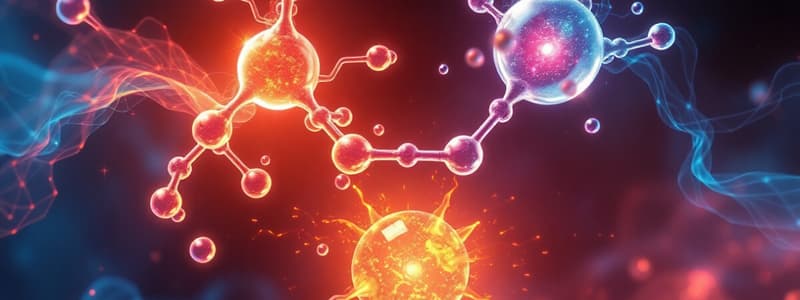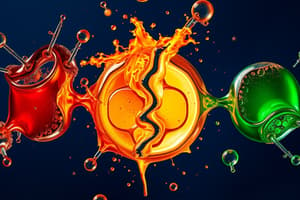Podcast
Questions and Answers
What kind of nucleophile is represented by $R-CH_2:$?
What kind of nucleophile is represented by $R-CH_2:$?
- An electrophile
- A free radical
- An uncharged nucleophile
- A nucleophile with a negative charge (correct)
Which type of carbon is able to react with a nucleophile through a carbocation intermediate?
Which type of carbon is able to react with a nucleophile through a carbocation intermediate?
- Secondary carbon
- Quaternary carbon
- Primary carbon
- Tertiary carbon (correct)
In a nucleophilic substitution reaction, what must be true about the leaving and entering groups?
In a nucleophilic substitution reaction, what must be true about the leaving and entering groups?
- They must be of different types
- One must always be an electrophile
- They must be the same type (correct)
- One must be a free radical
What type of reaction involves the addition of an electrophile to an alkene?
What type of reaction involves the addition of an electrophile to an alkene?
Which statement best describes a carbanion?
Which statement best describes a carbanion?
What type of compound results from free radical addition reactions?
What type of compound results from free radical addition reactions?
Which of the following statements accurately describes a free radical substitution reaction?
Which of the following statements accurately describes a free radical substitution reaction?
What characteristic defines a tertiary carbon in organic chemistry?
What characteristic defines a tertiary carbon in organic chemistry?
What is the definition of a Free Radical in organic chemistry?
What is the definition of a Free Radical in organic chemistry?
Which of the following best describes Heterolytic Cleavage?
Which of the following best describes Heterolytic Cleavage?
What type of ion does a Carbocation represent?
What type of ion does a Carbocation represent?
Which type of reaction involves the substitution of one atom or group for another?
Which type of reaction involves the substitution of one atom or group for another?
What characteristic defines an Electrophile?
What characteristic defines an Electrophile?
What is a common feature of reaction intermediates?
What is a common feature of reaction intermediates?
In which type of reaction do covalent bonds break and new ones form?
In which type of reaction do covalent bonds break and new ones form?
Which term describes a species that is electron-rich and can donate electrons?
Which term describes a species that is electron-rich and can donate electrons?
Flashcards are hidden until you start studying
Study Notes
Introduction to Organic Reactions
- Organic reactions involve the transformation of one organic compound into another.
- Covalent bonds break and new bonds form during these reactions.
- Bond breaking leads to the formation of reaction intermediates.
- Reaction intermediates are short-lived, unstable species formed during a chemical reaction.
Bond Breaking (Cleavage)
- Homolytic Cleavage: Equal breaking of a covalent bond, resulting in the formation of free radicals.
- A free radical is a neutral species with a carbon atom having three bonds and an unpaired electron.
- Heterolytic Cleavage: Unequal breaking of a covalent bond, resulting in the formation of ions.
- Carbanion: A species with a carbon atom having three bonds, eight outer-shell electrons (including one nonbonding pair), and a negative charge.
- Carbocation: A species with a carbon atom having three bonds and a positive charge.
Electrophiles and Nucleophiles
- Electrophile: An electron-deficient species that accepts electrons from nucleophiles.
- Electrophiles can be positively charged or neutral with an electron-deficient atom.
- Nucleophile: An electron-rich species that donates electrons to electrophiles.
- Nucleophiles can be negatively charged or neutral with an atom having a lone pair.
Bond Formation and Reaction Site
- Bond formation occurs between the reaction intermediate (free radical, carbocation, or carbanion) and the active part of the reagent (free radical, electrophile, or nucleophile).
- In organic reactions, the reaction occurs on the carbon atom.
- A carbon free radical is attacked by a free radical.
- A carbocation is attacked by a nucleophile.
- A carbanion is attacked by an electrophile.
Classification of Carbon Atoms
- Carbon atoms can be classified as primary (1o), secondary (2o), tertiary (3o), or quaternary (4o) based on the number of carbon atoms they are bonded to.
- 1o Carbon: Bonded to one carbon atom.
- 2o Carbon: Bonded to two carbon atoms.
- 3o Carbon: Bonded to three carbon atoms.
- 4o Carbon: Bonded to four carbon atoms.
Types of Chemical Reactions
- The type of reaction is determined by the type of carbon (free radical, carbocation, or carbanion) and the reagent attacking it.
- Substitution Reactions:
- The leaving and entering group are of the same type.
- Free Radical Substitution: A free radical replaces another free radical.
- Nucleophilic Substitution: A nucleophile replaces another nucleophile.
- Electrophilic Substitution: An electrophile replaces another electrophile.
- Addition Reactions:
- Reactions occur on a pi bond.
- Formation of saturated compounds at the expense of unsaturated compounds.
- Electrophilic Addition: An electrophile adds to a double or triple bond.
- Free Radical Addition: A free radical adds to a double or triple bond.
- Nucleophilic Addition: A nucleophile adds to a carbonyl group.
Examples of Common Reagents
- Alkyl halides
- Alcohols
- Carboxylic acids
- Amines
- Aldehydes
- Ketones
- Aromatic compounds
- Peroxides
Studying That Suits You
Use AI to generate personalized quizzes and flashcards to suit your learning preferences.




